![]()
![]()
![]() -----------------------------------------------------------
-----------------------------------------------------------![]()
![]()
![]() MAN IS CREATED FROM ALAQ : A LEECH-LIKE SUBSTANCE
MAN IS CREATED FROM ALAQ : A LEECH-LIKE SUBSTANCE ![]()
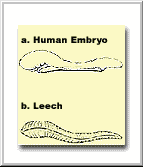
![]() A few years ago
a group of Arabs collected all information concerning
embryology from the Qur’aan, and followed the instruction of the Qur’aan:
A few years ago
a group of Arabs collected all information concerning
embryology from the Qur’aan, and followed the instruction of the Qur’aan:
![]() “If ye realise this not, ask Of those who possess the Message.” [Al-Qur’aan
16:43 & 21:7]
“If ye realise this not, ask Of those who possess the Message.” [Al-Qur’aan
16:43 & 21:7] ![]()
![]() All the information from the Qur’aan so gathered, was translated into English
and presented to Prof. (Dr.) Keith Moore, who was the Professor of
Embryology and Chairman of the Department of Anatomy at the University
of Toronto, in Canada. At present he is one of the highest authorities in the
field of Embryology. He was asked to give his opinion regarding the
information present in the Qur’aan concerning the field of embryology. After
carefully examining the translation of the Qur’aanic verses presented to him,
Dr. Moore said that most of the information concerning embryology
mentioned in the Qur’aan is in perfect conformity with modern discoveries in
the field of embryology and does not conflict with them in any way. He added
that there were however a few verses, on whose scientific accuracy he could
not comment. He could not say whether the statements were true or
false,
since he himself was not aware of the information contained therein.
There was also no mention of this information in modern writings and
studies
on embryology. One such verse is:
All the information from the Qur’aan so gathered, was translated into English
and presented to Prof. (Dr.) Keith Moore, who was the Professor of
Embryology and Chairman of the Department of Anatomy at the University
of Toronto, in Canada. At present he is one of the highest authorities in the
field of Embryology. He was asked to give his opinion regarding the
information present in the Qur’aan concerning the field of embryology. After
carefully examining the translation of the Qur’aanic verses presented to him,
Dr. Moore said that most of the information concerning embryology
mentioned in the Qur’aan is in perfect conformity with modern discoveries in
the field of embryology and does not conflict with them in any way. He added
that there were however a few verses, on whose scientific accuracy he could
not comment. He could not say whether the statements were true or
false,
since he himself was not aware of the information contained therein.
There was also no mention of this information in modern writings and
studies
on embryology. One such verse is:
![]() “Proclaim! (or Read!) In the name Of
thy Lord and Cherisher, Who created – Created man, out of A (mere)
clot Of congealed blood.” [Al-Qur’aan 96:1-2]
“Proclaim! (or Read!) In the name Of
thy Lord and Cherisher, Who created – Created man, out of A (mere)
clot Of congealed blood.” [Al-Qur’aan 96:1-2] ![]()
![]() The word alaq besides meaning a congealed clot of blood also means
something that clings, a leech-like substance. Dr. Keith Moore had no
knowledge whether an embryo in the initial stages appears like a leech. To
check this out he studied the initial stage of the embryo under a very powerful
microscope in his laboratory and compared what he observed with a diagram
of a leech and he was astonished at the striking resemblance between the two!
The word alaq besides meaning a congealed clot of blood also means
something that clings, a leech-like substance. Dr. Keith Moore had no
knowledge whether an embryo in the initial stages appears like a leech. To
check this out he studied the initial stage of the embryo under a very powerful
microscope in his laboratory and compared what he observed with a diagram
of a leech and he was astonished at the striking resemblance between the two! ![]()
![]() In the same manner, he acquired more information on embryology that was
hitherto not known to him, from the Qur’aan. Dr. Keith Moore answered
about eighty questions dealing with embryological data mentioned in the
Qur’aan and Hadith. Noting that the information contained in the Qur’aan and
Hadith was in full agreement with the latest discoveries in the field of
embryology, Prof. Moore said, “If I was asked these questions thirty years
ago, I would not have been able to answer half of them for lack of scientific
information”
In the same manner, he acquired more information on embryology that was
hitherto not known to him, from the Qur’aan. Dr. Keith Moore answered
about eighty questions dealing with embryological data mentioned in the
Qur’aan and Hadith. Noting that the information contained in the Qur’aan and
Hadith was in full agreement with the latest discoveries in the field of
embryology, Prof. Moore said, “If I was asked these questions thirty years
ago, I would not have been able to answer half of them for lack of scientific
information” ![]()
![]() Dr. Keith Moore had earlier authored the book, ‘The Developing Human’.
After acquiring new knowledge from the Qur’aan, he wrote, in 1982, the 3rd
edition of the same book, ‘The Developing Human’. The book was the
recipient of an award for the best medical book written by a single author.
This book has been translated into several major languages of the world and
is used as a textbook of embryology in the first year of medical studies.
In 1981, during the Seventh Medical Conference in Dammam, Saudi Arabia,
Dr. Moore said, “It has been a great pleasure for me to help clarify statements
in the Qur’aan about human development. It is clear to me that these
statements must have come to Muhammad from God or Allah, because
almost all of this knowledge was not discovered until many centuries later.
This proves to me that Muhammad must have been a messenger of God or
Allah.” 12
Dr. Keith Moore had earlier authored the book, ‘The Developing Human’.
After acquiring new knowledge from the Qur’aan, he wrote, in 1982, the 3rd
edition of the same book, ‘The Developing Human’. The book was the
recipient of an award for the best medical book written by a single author.
This book has been translated into several major languages of the world and
is used as a textbook of embryology in the first year of medical studies.
In 1981, during the Seventh Medical Conference in Dammam, Saudi Arabia,
Dr. Moore said, “It has been a great pleasure for me to help clarify statements
in the Qur’aan about human development. It is clear to me that these
statements must have come to Muhammad from God or Allah, because
almost all of this knowledge was not discovered until many centuries later.
This proves to me that Muhammad must have been a messenger of God or
Allah.” 12 ![]()
![]() Dr. Joe Leigh Simpson, Chairman of the Department of Obstetrics and
Gynaecology, at the Baylor College of Medicine, Houston, U.S.A.,
proclaims: “...these Hadiths, sayings of Muhammad (pbuh) could not have
been obtained on the basis of the scientific knowledge that was available at
the time of the writer (7 th century). It follows that not only is there no conflict
between genetics and religion (Islam) but in fact religion (Islam) may guide
science by adding revelation to some of the traditional scientific
approaches… there exist statements in the Qur’aan shown centuries later to
be valid which support knowledge in the Qur’aan having been derived from
God.”
Dr. Joe Leigh Simpson, Chairman of the Department of Obstetrics and
Gynaecology, at the Baylor College of Medicine, Houston, U.S.A.,
proclaims: “...these Hadiths, sayings of Muhammad (pbuh) could not have
been obtained on the basis of the scientific knowledge that was available at
the time of the writer (7 th century). It follows that not only is there no conflict
between genetics and religion (Islam) but in fact religion (Islam) may guide
science by adding revelation to some of the traditional scientific
approaches… there exist statements in the Qur’aan shown centuries later to
be valid which support knowledge in the Qur’aan having been derived from
God.” ![]()
(The reference for this statement is the video tape titled ‘This is the Truth’. For a copy of this video tape contact the Islamic Research Foundation.)
![]() MAN CREATED FROM A DROP EMITTED FROM BETWEEN
THE BACK BONE AND THE RIBS
MAN CREATED FROM A DROP EMITTED FROM BETWEEN
THE BACK BONE AND THE RIBS ![]()

![]() “Now let man but think From what he is created! He is created from A
drop emitted – Proceeding from between The back bone and the ribs.”
[Al-Qur’aan 86:5-7]
“Now let man but think From what he is created! He is created from A
drop emitted – Proceeding from between The back bone and the ribs.”
[Al-Qur’aan 86:5-7] ![]()
![]() In embryonic stages, the reproductive organs of the male and female, i.e.
the
testicles and the ovaries, begin their development near the kidney between the
spinal column and the eleventh and twelfth ribs. Later they descend; the
female gonads (ovaries) stop in the pelvis while the male gonads (testicles)
continue their descent before birth to reach the scrotum through the inguinal
canal. Even in the adult after the descent of the reproductive organ,
these
organs receive their nerve supply and blood supply from the Abdominal
Aorta, which is in the area between the backbone (spinal column) and the
ribs. Even the lymphatic drainage and the venous return goes to the same
area.
In embryonic stages, the reproductive organs of the male and female, i.e.
the
testicles and the ovaries, begin their development near the kidney between the
spinal column and the eleventh and twelfth ribs. Later they descend; the
female gonads (ovaries) stop in the pelvis while the male gonads (testicles)
continue their descent before birth to reach the scrotum through the inguinal
canal. Even in the adult after the descent of the reproductive organ,
these
organs receive their nerve supply and blood supply from the Abdominal
Aorta, which is in the area between the backbone (spinal column) and the
ribs. Even the lymphatic drainage and the venous return goes to the same
area. ![]()
![]() HUMAN BEINGS CREATED FROM NUTFAH (Minute Quantity of Liquid)
HUMAN BEINGS CREATED FROM NUTFAH (Minute Quantity of Liquid) ![]()
![]() The Glorious Qur’aan mentions no less than eleven times that the human
being is created from nutfah, which means a minute quantity of liquid or a
trickle of liquid which remains after emptying a cup. This is mentioned in
several verses of the Qur’aan including 22:5 and 23:13. 13
Science has confirmed in recent times that only one out of an average of
three
million sperms is required for fertilising the ovum. This means that only a
1/three millionth part or 0.00003% of the quantity of sperms that are emitted
is required for fertilisation.
The Glorious Qur’aan mentions no less than eleven times that the human
being is created from nutfah, which means a minute quantity of liquid or a
trickle of liquid which remains after emptying a cup. This is mentioned in
several verses of the Qur’aan including 22:5 and 23:13. 13
Science has confirmed in recent times that only one out of an average of
three
million sperms is required for fertilising the ovum. This means that only a
1/three millionth part or 0.00003% of the quantity of sperms that are emitted
is required for fertilisation. ![]()
(The same is also mentioned in the Qur'aan in 16:4, 18:37, 35:11, 36:77, 40:67, 53:46, 75:37, 76:2 and 80:19.)
![]() HUMAN BEINGS CREATED FROM SULALAH (Quintessence of liquid)
HUMAN BEINGS CREATED FROM SULALAH (Quintessence of liquid) ![]()
![]() “And made his progeny From a quintessence Of the nature of A fluid
despised.” [Al-Qur’aan 32:8]
“And made his progeny From a quintessence Of the nature of A fluid
despised.” [Al-Qur’aan 32:8] ![]()
![]() The Arabic word sulâlah means quintessence or the best part of a whole. We
have come to know now that only one single spermatozoon that penetrates the
ovum is required for fertilization, out of the several millions produced by
man. That one spermatozoon out of several millions, is referred to in the
Qur’aan as sulâlah. Sulâlah also means gentle extraction from a
fluid. The
fluid refers to both male and female germinal fluids containing gametes. Both
ovum and sperm are gently extracted from their environments in the process
of fertilization.
The Arabic word sulâlah means quintessence or the best part of a whole. We
have come to know now that only one single spermatozoon that penetrates the
ovum is required for fertilization, out of the several millions produced by
man. That one spermatozoon out of several millions, is referred to in the
Qur’aan as sulâlah. Sulâlah also means gentle extraction from a
fluid. The
fluid refers to both male and female germinal fluids containing gametes. Both
ovum and sperm are gently extracted from their environments in the process
of fertilization. ![]()
![]() MAN CREATED FROM NUTFATUN AMSHAAJ (Mingled liquids)
MAN CREATED FROM NUTFATUN AMSHAAJ (Mingled liquids) ![]()
![]() Consider the following Qur’aanic verse: “Verily We created Man from a
drop Of mingled sperm.” [Al-Qur’aan 76:2]
Consider the following Qur’aanic verse: “Verily We created Man from a
drop Of mingled sperm.” [Al-Qur’aan 76:2] ![]()
![]() The Arabic word nutfatin amshaajin means mingled liquids. According to
some commentators of the Qur’aan, mingled liquids refers to the
male or
female agents or liquids. After mixture of male and female gamete, the
zygote
still remains nutfah. Mingled liquids can also refer to spermatic fluid that is
formed of various secretions that come from various glands.
Therefore nutfatin amsaj, i.e. a minute quantity of mingled fluids refers to the
male and female gametes (germinal fluids or cells) and part of the
surrounding fluids.
The Arabic word nutfatin amshaajin means mingled liquids. According to
some commentators of the Qur’aan, mingled liquids refers to the
male or
female agents or liquids. After mixture of male and female gamete, the
zygote
still remains nutfah. Mingled liquids can also refer to spermatic fluid that is
formed of various secretions that come from various glands.
Therefore nutfatin amsaj, i.e. a minute quantity of mingled fluids refers to the
male and female gametes (germinal fluids or cells) and part of the
surrounding fluids. ![]()
![]() SEX DETERMINATION
SEX DETERMINATION ![]()
![]() The sex of a fetus is determined by the nature of the sperm and not the ovum.
The sex of the child, whether female or male, depends on whether the
23rd
pair of chromosomes is XX or XY respectively. Primarily sex determination
occurs at fertilization and depends upon the type of sex chromosome in the
sperm that fertilizes an ovum. If it is an ‘X’ bearing sperm that fertilizes the
ovum, the fetus is a female and if it is a ‘Y’ bearing sperm then the fetus is a
male.
The sex of a fetus is determined by the nature of the sperm and not the ovum.
The sex of the child, whether female or male, depends on whether the
23rd
pair of chromosomes is XX or XY respectively. Primarily sex determination
occurs at fertilization and depends upon the type of sex chromosome in the
sperm that fertilizes an ovum. If it is an ‘X’ bearing sperm that fertilizes the
ovum, the fetus is a female and if it is a ‘Y’ bearing sperm then the fetus is a
male. ![]()
![]() “That He did create In pairs – male and female, From a seed when
lodged (In its place).” [Al-Qur’aan 53:45-46]
“That He did create In pairs – male and female, From a seed when
lodged (In its place).” [Al-Qur’aan 53:45-46] ![]()
![]() The Arabic word nutfah means a minute quantity of liquid and tumnâ means
ejaculated or planted. Therefore nutfah specifically refers to sperm because it
is ejaculated. The Qur’aan says:
The Arabic word nutfah means a minute quantity of liquid and tumnâ means
ejaculated or planted. Therefore nutfah specifically refers to sperm because it
is ejaculated. The Qur’aan says:
![]() “Was he not a drop of sperm emitted (In
lowly form)? “Then did he become A clinging clot; Then did (Allah)
make And fashion (him) In due proportion. “And of him He made Two
sexes, male And female.” [Al-Qur’aan 75:37-39]
“Was he not a drop of sperm emitted (In
lowly form)? “Then did he become A clinging clot; Then did (Allah)
make And fashion (him) In due proportion. “And of him He made Two
sexes, male And female.” [Al-Qur’aan 75:37-39] ![]()
![]() Here again it is mentioned that a small quantity (drop) of sperm (indicated by
the word nutfatan min maniyyin) which comes from the man is responsible
for the sex of the fetus.
Here again it is mentioned that a small quantity (drop) of sperm (indicated by
the word nutfatan min maniyyin) which comes from the man is responsible
for the sex of the fetus. ![]()
![]() Mothers-in-law in the Indian subcontinent, by and large prefer having male
grandchildren and often blame their daughters-in-law if the child is not of the
desired sex. If only they knew that the determining factor is the
nature of the
male sperm and not the female ovum! If they were to blame anybody, they
should blame their sons and not their daughters-in-law since both the
Qur’aan
and Science hold that it is the male fluid that is responsible for the sex of the
child!
Mothers-in-law in the Indian subcontinent, by and large prefer having male
grandchildren and often blame their daughters-in-law if the child is not of the
desired sex. If only they knew that the determining factor is the
nature of the
male sperm and not the female ovum! If they were to blame anybody, they
should blame their sons and not their daughters-in-law since both the
Qur’aan
and Science hold that it is the male fluid that is responsible for the sex of the
child! ![]()
![]() FOETUS PROTECTED BY THREE VEILS OF DARKNESS
FOETUS PROTECTED BY THREE VEILS OF DARKNESS ![]()
![]() “He makes you, In the wombs of your mothers, In stages, one after
another, In three veils of darkness.” [Al-Qur’aan 39:6]
“He makes you, In the wombs of your mothers, In stages, one after
another, In three veils of darkness.” [Al-Qur’aan 39:6]
![]()
![]() According to Prof. Keith Moore these three veils of darkness in the Qur’aan
refer to:
According to Prof. Keith Moore these three veils of darkness in the Qur’aan
refer to:![]()
-
anterior abdominal wall of the mother
-
the uterine wall
-
the amnio-chorionic membrane.
![]() EMBRYONIC STAGES
EMBRYONIC STAGES ![]()
![]() “Man We did create From a quintessence (of clay); Then We placed him
As (a drop of) sperm In a place of rest, firmly fixed; Then We made the
sperm Into a clot of congealed blood; Then of that clot We made A
(foetus) lump; then We Made out of that lump Bones and clothed the
bones With flesh; then We developed Out of it another creature. So
blessed be Allah, The Best to create!” [Al-Qur’aan 23:12-14]
“Man We did create From a quintessence (of clay); Then We placed him
As (a drop of) sperm In a place of rest, firmly fixed; Then We made the
sperm Into a clot of congealed blood; Then of that clot We made A
(foetus) lump; then We Made out of that lump Bones and clothed the
bones With flesh; then We developed Out of it another creature. So
blessed be Allah, The Best to create!” [Al-Qur’aan 23:12-14]
![]()
![]() In this verse Allah states that man is created from a
small quantity of liquid
which is placed in a place of rest, firmly fixed (well established or lodged) for
which the Arabic word qarârin makîn is used.
In this verse Allah states that man is created from a
small quantity of liquid
which is placed in a place of rest, firmly fixed (well established or lodged) for
which the Arabic word qarârin makîn is used. ![]()
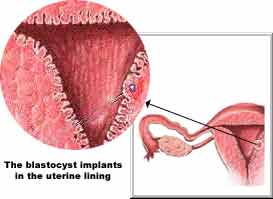
![]() The uterus is well protected from the posterior by the spinal column
supported firmly by the back muscles. The embryo is further protected by the
amniotic sac containing the amniotic fluid. Thus the
foetus has a well
protected dwelling place.
The uterus is well protected from the posterior by the spinal column
supported firmly by the back muscles. The embryo is further protected by the
amniotic sac containing the amniotic fluid. Thus the
foetus has a well
protected dwelling place. 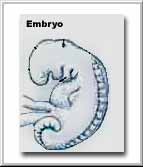 This small quantity of fluid is made into alaqah,
meaning something which clings. It also means a leech-like
substance. Both
descriptions are scientifically acceptable as in the very early stages the foetus
clings to the wall and also appears to resemble the leech in shape. It also
behaves like a
leech (blood sucker) and acquires its blood supply from the mother through
the placenta. The third meaning of the word alaqah is a blood
clot. During
this alaqah stage, which spans the third and fourth week of pregnancy, the
blood clots within closed vessels. Hence the embryo acquires the appearance
of a blood clot in addition to acquiring the appearance of a leech.
In 1677,
Hamm and Leeuwenhoek were the first scientists to observe human sperm
cells (spermatozoa) using a microscope. They thought that a sperm cell
contained a miniature human being which grew in the uterus to form a
newborn.
This small quantity of fluid is made into alaqah,
meaning something which clings. It also means a leech-like
substance. Both
descriptions are scientifically acceptable as in the very early stages the foetus
clings to the wall and also appears to resemble the leech in shape. It also
behaves like a
leech (blood sucker) and acquires its blood supply from the mother through
the placenta. The third meaning of the word alaqah is a blood
clot. During
this alaqah stage, which spans the third and fourth week of pregnancy, the
blood clots within closed vessels. Hence the embryo acquires the appearance
of a blood clot in addition to acquiring the appearance of a leech.
In 1677,
Hamm and Leeuwenhoek were the first scientists to observe human sperm
cells (spermatozoa) using a microscope. They thought that a sperm cell
contained a miniature human being which grew in the uterus to form a
newborn. 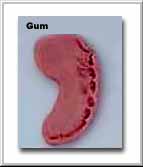 This was known as the perforation theory. When scientists
discovered that the ovum was bigger than the sperm, it was thought by
De
Graf and others that the foetus existed in a miniature form in the ovum. Later,
in the 18th century Maupertuis propagated the theory of biparental
inheritance. The alaqah is transformed into mudghah which means
‘something that is chewed (having teeth marks)’ and also something that is
tacky and small which can be put in the mouth like gum. Both these
explanations are scientifically correct. Prof. Keith Moore took a piece of
plaster seal and made it into the size and shape of the early stage of foetus and
chewed it between the teeth to make it into a ‘Mudgha’. He compared this
with the photographs of the early stage of foetus. The teeth marks resembled
the ‘somites’ which is the early formation of the spinal column.
This was known as the perforation theory. When scientists
discovered that the ovum was bigger than the sperm, it was thought by
De
Graf and others that the foetus existed in a miniature form in the ovum. Later,
in the 18th century Maupertuis propagated the theory of biparental
inheritance. The alaqah is transformed into mudghah which means
‘something that is chewed (having teeth marks)’ and also something that is
tacky and small which can be put in the mouth like gum. Both these
explanations are scientifically correct. Prof. Keith Moore took a piece of
plaster seal and made it into the size and shape of the early stage of foetus and
chewed it between the teeth to make it into a ‘Mudgha’. He compared this
with the photographs of the early stage of foetus. The teeth marks resembled
the ‘somites’ which is the early formation of the spinal column. ![]()
![]() This mudghah is transformed into bones (izâm). The bones are clothed with
intact flesh or muscles (lahm). Then Allah makes it into another creature.
Prof. Marshall Johnson is one of the leading scientists in US, and is the head
of the Department of Anatomy and Director of the Daniel Institute at the
Thomas Jefferson University in Philadelphia in US. He was asked to
comment on the verses of the Qur’aan dealing with embryology. He said that
the verses of the Qur’aan describing the embryological stages cannot be a
coincidence. He said it was probable that Muhammad (pbuh) had a powerful
microscope. On being reminded that the Qur’aan was revealed 1400 years
ago, and microscopes were invented centuries after the time of Prophet
Muhammad (pbuh), Prof. Johnson laughed and admitted that the
first
microscope invented could not magnify more than 10 times and could not
show a clear picture. Later he said: “I see nothing here in conflict with the
concept that Divine intervention was involved when Muhammad (pbuh)
recited the Qur’aan.”
This mudghah is transformed into bones (izâm). The bones are clothed with
intact flesh or muscles (lahm). Then Allah makes it into another creature.
Prof. Marshall Johnson is one of the leading scientists in US, and is the head
of the Department of Anatomy and Director of the Daniel Institute at the
Thomas Jefferson University in Philadelphia in US. He was asked to
comment on the verses of the Qur’aan dealing with embryology. He said that
the verses of the Qur’aan describing the embryological stages cannot be a
coincidence. He said it was probable that Muhammad (pbuh) had a powerful
microscope. On being reminded that the Qur’aan was revealed 1400 years
ago, and microscopes were invented centuries after the time of Prophet
Muhammad (pbuh), Prof. Johnson laughed and admitted that the
first
microscope invented could not magnify more than 10 times and could not
show a clear picture. Later he said: “I see nothing here in conflict with the
concept that Divine intervention was involved when Muhammad (pbuh)
recited the Qur’aan.” ![]()
![]() According to Dr. Keith Moore, the modern classification of
embryonic
development stages which is adopted throughout the world, is not easily
comprehensible, since it identifies stages on a numerical basis i.e.
stage I,
stage II, etc. The divisions revealed in the Qur’aan are based on distinct and
easily identifiable forms or shapes, which the embryo passes through. These
are based on different phases of prenatal development and provide elegant
scientific descriptions that are comprehensible and practical.
Similar embryological stages of human development have been described in
the following verses:
According to Dr. Keith Moore, the modern classification of
embryonic
development stages which is adopted throughout the world, is not easily
comprehensible, since it identifies stages on a numerical basis i.e.
stage I,
stage II, etc. The divisions revealed in the Qur’aan are based on distinct and
easily identifiable forms or shapes, which the embryo passes through. These
are based on different phases of prenatal development and provide elegant
scientific descriptions that are comprehensible and practical.
Similar embryological stages of human development have been described in
the following verses:
![]() “Was he not a drop Of sperm emitted (In lowly
form)? Then did he become a clinging clot; Then did (Allah) make and
fashion (him) In due proportion. And of him He made Two sexes, male
and female.” [Al-Qur’aan 75:37-39]
“Was he not a drop Of sperm emitted (In lowly
form)? Then did he become a clinging clot; Then did (Allah) make and
fashion (him) In due proportion. And of him He made Two sexes, male
and female.” [Al-Qur’aan 75:37-39] ![]()
![]() “Him Who created thee, fashioned thee in due proportion, And gave thee
a just bias; In whatever Form He wills, Does He put thee together.” [Al-Qur’aan
82:7-8]
“Him Who created thee, fashioned thee in due proportion, And gave thee
a just bias; In whatever Form He wills, Does He put thee together.” [Al-Qur’aan
82:7-8] ![]()
![]() EMBRYO PARTLY FORMED AND PARTLY UNFORMED
EMBRYO PARTLY FORMED AND PARTLY UNFORMED ![]()
![]() At the mugdhah stage, if an
incision is made in the embryo and the internal
organ is dissected, it will be seen that most of them are formed while the
others are not yet completely formed.
At the mugdhah stage, if an
incision is made in the embryo and the internal
organ is dissected, it will be seen that most of them are formed while the
others are not yet completely formed. ![]()
![]() According to
Prof. Johnson, if we describe the embryo as a complete
creation,
then we are only describing that part which is already created. If we describe
it as an incomplete creation, then we are only describing that part which is not
yet created. So, is it a complete creation or an incomplete creation? There is
no better description of this stage of embryo genesis than the Qur’aanic
description, “partly formed and partly unformed”, as in the following
verse:
According to
Prof. Johnson, if we describe the embryo as a complete
creation,
then we are only describing that part which is already created. If we describe
it as an incomplete creation, then we are only describing that part which is not
yet created. So, is it a complete creation or an incomplete creation? There is
no better description of this stage of embryo genesis than the Qur’aanic
description, “partly formed and partly unformed”, as in the following
verse:
![]() “We created you Out of dust, then out of Sperm, then out of a leech-like
Clot, then out of a morsel Of flesh, partly formed And partly unformed.”
[Al-Qur’aan 22:5]
“We created you Out of dust, then out of Sperm, then out of a leech-like
Clot, then out of a morsel Of flesh, partly formed And partly unformed.”
[Al-Qur’aan 22:5] ![]()
![]() Scientifically we know that at this early stage of development there are some
cells which are differentiated and there are some cells that are
undifferentiated – some organs are formed and yet others unformed.
Scientifically we know that at this early stage of development there are some
cells which are differentiated and there are some cells that are
undifferentiated – some organs are formed and yet others unformed. ![]()
![]() SENSE OF HEARING AND SIGHT
SENSE OF HEARING AND SIGHT ![]()
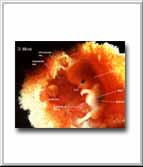
![]() The first sense to develop in a developing human embryo is
hearing. The
foetus can hear sounds after the 24th week. Subsequently, the sense of sight is
developed and by the 28th week, the retina becomes sensitive to light.
Consider the following Qur’aanic verses related to the development of the
senses in the embryo:
The first sense to develop in a developing human embryo is
hearing. The
foetus can hear sounds after the 24th week. Subsequently, the sense of sight is
developed and by the 28th week, the retina becomes sensitive to light.
Consider the following Qur’aanic verses related to the development of the
senses in the embryo: ![]()
![]() “And He gave You (the faculties of) hearing and
sight and feeling (And understanding).” [Al-Qur’aan 32:9]
“And He gave You (the faculties of) hearing and
sight and feeling (And understanding).” [Al-Qur’aan 32:9]
![]()
![]() “Verily We created Man from a drop Of mingled sperm, In order to try
him: So We gave him (the gifts), Of Hearing and Sight.” [Al-Qur’aan
76:2]
“Verily We created Man from a drop Of mingled sperm, In order to try
him: So We gave him (the gifts), Of Hearing and Sight.” [Al-Qur’aan
76:2] ![]()
![]() “It is He Who has created For you (the faculties of) Hearing, sight,
feeling And understanding: little thanks It is ye give!” [Al-Qur’aan 23:78]
“It is He Who has created For you (the faculties of) Hearing, sight,
feeling And understanding: little thanks It is ye give!” [Al-Qur’aan 23:78]
![]()
In all these verses the sense of hearing is mentioned before that of sight.
Thus
the Qur’aanic description matches with the discoveries in modern
embryology. ![]()
![]()
![]() -----------------------------------------------------------
-----------------------------------------------------------![]()
![]()
![]() FINGERPRINTS
FINGERPRINTS ![]()
![]() “Does man think that We Cannot assemble his bones? Nay, We are able
to put Together in perfect order The very tips of his fingers.” [Al-Qur’aan
75:3-4]
“Does man think that We Cannot assemble his bones? Nay, We are able
to put Together in perfect order The very tips of his fingers.” [Al-Qur’aan
75:3-4] ![]()
![]() Unbelievers argue regarding resurrection taking place after bones of dead
people have disintegrated in the earth and how each individual would be
identified on the Day of Judgment. Almighty Allah answers that He can not
only assemble our bones but can also reconstruct perfectly our very
fingertips.
Unbelievers argue regarding resurrection taking place after bones of dead
people have disintegrated in the earth and how each individual would be
identified on the Day of Judgment. Almighty Allah answers that He can not
only assemble our bones but can also reconstruct perfectly our very
fingertips. ![]()
![]() Why does the Qur’aan, while speaking about determination of the
identity of
the individual, speak specifically about fingertips? In
1880, fingerprinting
became the scientific method of identification, after research done by
Sir
Francis Golt. No two persons in the world can ever have exactly the same
fingerprint pattern. That is the reason why police forces worldwide use
fingerprints to identify the criminal. 1400 years ago, who could have known
the uniqueness of each human’s fingerprint? Surely it could have been none
other than the Creator Himself!
Why does the Qur’aan, while speaking about determination of the
identity of
the individual, speak specifically about fingertips? In
1880, fingerprinting
became the scientific method of identification, after research done by
Sir
Francis Golt. No two persons in the world can ever have exactly the same
fingerprint pattern. That is the reason why police forces worldwide use
fingerprints to identify the criminal. 1400 years ago, who could have known
the uniqueness of each human’s fingerprint? Surely it could have been none
other than the Creator Himself! ![]()
![]() PAIN RECEPTORS PRESENT IN THE SKIN
PAIN RECEPTORS PRESENT IN THE SKIN ![]()
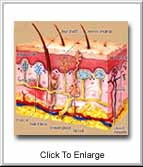
![]() It was thought that the sense of feeling and pain was only dependent on the
brain. Recent discoveries prove that there are pain receptors present in the
skin without which a person would not be able to feel pain. When a doctor
examines a patient suffering from burn injuries, he verifies the
degree of
burns by a pinprick. If the patient feels pain, the doctor is
happy, because it
indicates that the burns are superficial and the pain receptors are intact. On
the other hand if the patient does not feel any pain, it indicates that it is a deep
burn and the pain receptors have been destroyed. The Qur’aan gives an
indication of the existence of pain receptors in the following
verse:
It was thought that the sense of feeling and pain was only dependent on the
brain. Recent discoveries prove that there are pain receptors present in the
skin without which a person would not be able to feel pain. When a doctor
examines a patient suffering from burn injuries, he verifies the
degree of
burns by a pinprick. If the patient feels pain, the doctor is
happy, because it
indicates that the burns are superficial and the pain receptors are intact. On
the other hand if the patient does not feel any pain, it indicates that it is a deep
burn and the pain receptors have been destroyed. The Qur’aan gives an
indication of the existence of pain receptors in the following
verse:
![]() “Those
who reject Our signs, We shall soon Cast into the Fire; As often as their
skins Are roasted through, We shall change them For fresh skins, That
they may taste The Penalty: for Allah Is Exalted in Power, Wise.” [Al-Qur’aan
4:56]
“Those
who reject Our signs, We shall soon Cast into the Fire; As often as their
skins Are roasted through, We shall change them For fresh skins, That
they may taste The Penalty: for Allah Is Exalted in Power, Wise.” [Al-Qur’aan
4:56] ![]()
![]() Prof. Tagatat Tejasen, Chairman of the Department of Anatomy at Chiang
Mai University in Thailand, has spent a great amount of time on research of
pain receptors. Initially he could not believe that the Qur’aan mentioned this
scientific fact 1,400 years ago. He later verified the translation of this
particular Qur’aanic verse. Prof. Tejasen was so impressed by the scientific
accuracy of the Qur’aanic verse, that at the 8th Saudi Medical Conference
held in Riyadh on the Scientific Signs of Qur’aan and Sunnah he proclaimed
in public: “There is no God but Allah and Muhammad (pbuh) is His
Messenger.”
Prof. Tagatat Tejasen, Chairman of the Department of Anatomy at Chiang
Mai University in Thailand, has spent a great amount of time on research of
pain receptors. Initially he could not believe that the Qur’aan mentioned this
scientific fact 1,400 years ago. He later verified the translation of this
particular Qur’aanic verse. Prof. Tejasen was so impressed by the scientific
accuracy of the Qur’aanic verse, that at the 8th Saudi Medical Conference
held in Riyadh on the Scientific Signs of Qur’aan and Sunnah he proclaimed
in public: “There is no God but Allah and Muhammad (pbuh) is His
Messenger.” ![]()
![]()
![]() -----------------------------------------------------------
-----------------------------------------------------------![]()
![]()
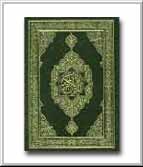
![]() To attribute the presence of scientific facts in the Qur’aan to coincidence
would be against common sense and a true scientific approach. The Qur’aan
invites all humans to reflect on the Creation of this universe in the
verse:
To attribute the presence of scientific facts in the Qur’aan to coincidence
would be against common sense and a true scientific approach. The Qur’aan
invites all humans to reflect on the Creation of this universe in the
verse:
![]() “Behold! In the creation Of the heavens and the earth, And the
alternation Of Night and Day – There are indeed Signs For men of
understanding.” [Al-Qur’aan 3:190]
“Behold! In the creation Of the heavens and the earth, And the
alternation Of Night and Day – There are indeed Signs For men of
understanding.” [Al-Qur’aan 3:190] ![]()
![]() The scientific evidences of the Qur’aan clearly prove its Divine Origin. No
human could have produced a book, fourteen hundred years ago, that would
contain profound scientific facts, to be discovered by humankind centuries
later. The Qur’aan, however, is not a book of Science but a book of ‘Signs’.
These signs invite Man to realize the purpose of his existence on earth, and to
live in harmony with Nature. The Qur’aan is truly a message from Allah, the
Creator and Sustainer of the universe. It contains the same message of the
Oneness of God, that was preached by all prophets, right from Adam, Moses,
Jesus to Muhammad (peace be upon them).
The scientific evidences of the Qur’aan clearly prove its Divine Origin. No
human could have produced a book, fourteen hundred years ago, that would
contain profound scientific facts, to be discovered by humankind centuries
later. The Qur’aan, however, is not a book of Science but a book of ‘Signs’.
These signs invite Man to realize the purpose of his existence on earth, and to
live in harmony with Nature. The Qur’aan is truly a message from Allah, the
Creator and Sustainer of the universe. It contains the same message of the
Oneness of God, that was preached by all prophets, right from Adam, Moses,
Jesus to Muhammad (peace be upon them). ![]()
![]() Several detailed tomes have been written on the subject of Qur’aan and
modern science and further research in this field is on. Inshallah, this research
will help mankind to come closer to the Word of the Almighty. This booklet
contains only a few of the scientific facts present in the Qur’aan. I cannot
claim to have done full justice to the subject. Prof.Tejasen accepted Islam on the strength of just one scientific ‘sign’ mentioned
in the Qu’ran. Some people may require ten signs while some may require
hundred signs to be convinced about the Divine Origin of the Qur’aan. Some
would be unwilling to accept the Truth even after being shown a thousand
signs. The Qur’aan condemns such a closed mentality in the
verse:
Several detailed tomes have been written on the subject of Qur’aan and
modern science and further research in this field is on. Inshallah, this research
will help mankind to come closer to the Word of the Almighty. This booklet
contains only a few of the scientific facts present in the Qur’aan. I cannot
claim to have done full justice to the subject. Prof.Tejasen accepted Islam on the strength of just one scientific ‘sign’ mentioned
in the Qu’ran. Some people may require ten signs while some may require
hundred signs to be convinced about the Divine Origin of the Qur’aan. Some
would be unwilling to accept the Truth even after being shown a thousand
signs. The Qur’aan condemns such a closed mentality in the
verse:
![]() “Deaf,
dumb and blind, They will not return (To the path).” [Al-Qur’aan 2:18]
“Deaf,
dumb and blind, They will not return (To the path).” [Al-Qur’aan 2:18]
![]()
![]() The Qur’aan contains a complete code of life for the individual and society.
Alhamdulillah (Praise be to Allah), the Qur’aanic way of life is far superior to
the ‘isms’ that modern man has invented out of sheer
ignorance. Who can
give better guidance than the Creator Himself?
The Qur’aan contains a complete code of life for the individual and society.
Alhamdulillah (Praise be to Allah), the Qur’aanic way of life is far superior to
the ‘isms’ that modern man has invented out of sheer
ignorance. Who can
give better guidance than the Creator Himself? ![]()
![]()
![]() I pray that this humble effort is accepted by Allah, to whom I pray for mercy
and guidance (Aameen).
I pray that this humble effort is accepted by Allah, to whom I pray for mercy
and guidance (Aameen).
![]()
![]()
![]() -----------------------------------------------------------
-----------------------------------------------------------![]()
![]()



